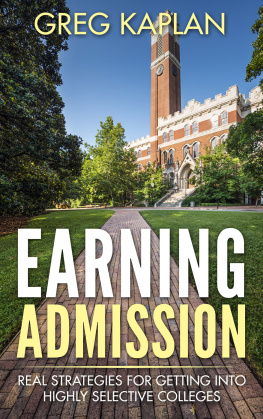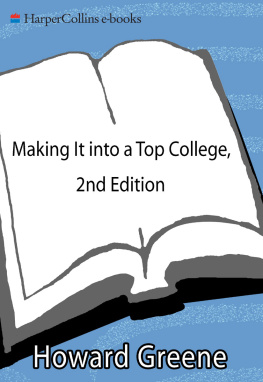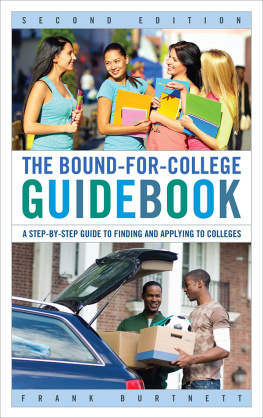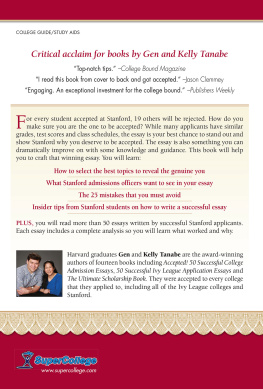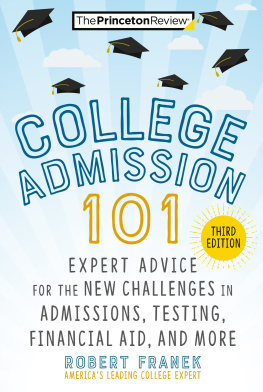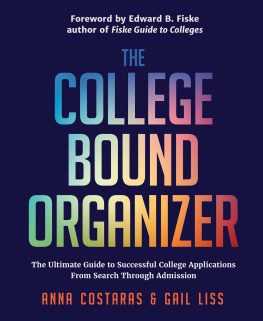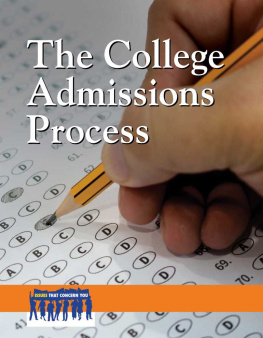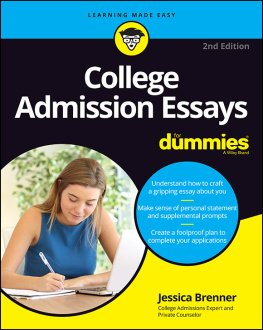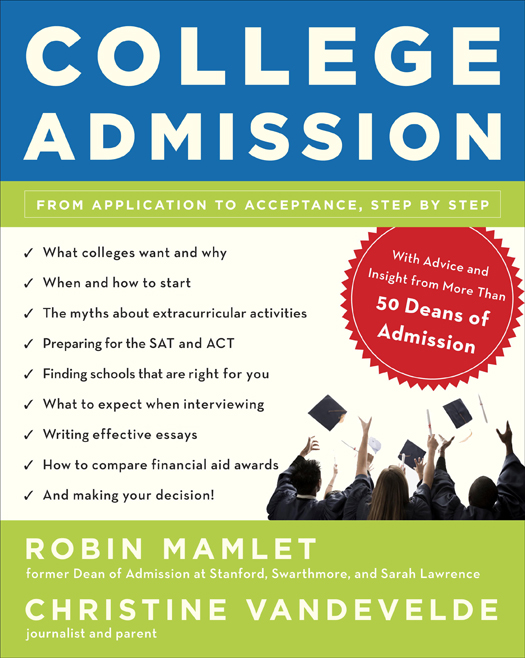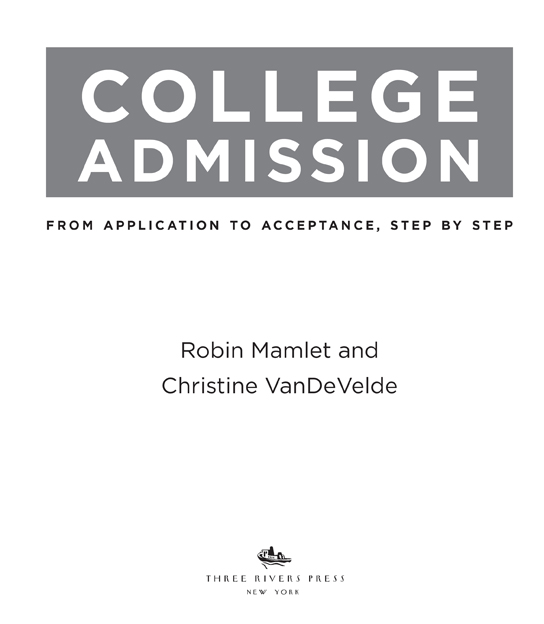Copyright 2011 by Robin Mamlet and Christine VanDeVelde
All rights reserved.
Published in the United States by Three Rivers Press, an imprint of the Crown Publishing Group, a division of Random House LLC, a Penguin Random House Company, New York.
www.crownpublishing.com
Three Rivers Press and the Tugboat design are registered trademarks of Random House LLC.
Originally published in the United States in slightly different form by Three Rivers Press, an imprint of the Crown Publishing Group, a division of Random House LLC, New York, in 2011.
Grateful acknowledgment is made to the following for permission to reprint previously published material:
National Association for College Admission Counseling: Five Secrets to Success for Undocumented Students from the Journal of College Admission , Winter 2010 issue, number 206, copyright 2010 by National Association for College Admission Counseling. Reprinted by permission of National Association for College Admission Counseling.
George Waters, TheWaBlog.com: excerpt from Sick of Standardized Testing? Bubble THIS in by George Waters. Reprinted by permission of George Waters, TheWaBlog.com.
Library of Congress Cataloging-in-Publication Data
Mamlet, Robin.
College admission : from application to acceptance, step by step / Robin Mamlet, Christine VanDeVelde.
p. cm.
Summary: Anxiety about getting into college has never been greater, and as an admission dean at Stanford, Swarthmore, and Sarah Lawrence, Robin Mamlet has had a front-row seat to all the angst and antics. Now she reveals the truth about admission, and the simple, honest approaches that really do work. Journalist and coauthor Christine VanDeVelde is a parent who has experienced the process firsthand and knows the questions, anxieties, and concerns of students and parents. College Admission directly addresses all the questions that plague parents and students along the way to an acceptance letter and will be their definitive resource during the sophomore, junior, and senior years of high school. Provided by publisher.
1. Universities and collegesUnited StatesAdmission. 2. College choiceUnited States.
3. Student aidUnited States. I. VanDeVelde, Christine. II. Title.
LB2351.2.M24 2011
378.1980973dc22 2011007978
ISBN 978-0-307-59032-9
eBook ISBN 978-0-307-59033-6
Cartoons by Mark Anderson
Cover design by Alison Forner
Cover photography by Image Source
Updated Edition
v3.1
To Austin, Chloe, Don, and Roark
Contents
Getting into college is not as hard as it looksthe real challenges and opportunities
There is no secret, but its not random Understanding what colleges want The perfect candidate may be imperfectbut authentic
When and how to start Dialing down the anxiety
The high school counselor, a powerful advocate for the student Private counselorsthe benefits and drawbacks How colleges interact with counselors Overpackaged applicants
The cornerstone of the application Defining a challenging curriculum How to select courses Course work options: electives, honors courses, International Baccalaureate programs, and Advanced Placement classes How many APs? Grades and the GPA Class ranking Grade inflation How colleges evaluate your grades and courses Achieving balance between high grades, demanding courses, and personal time
The myths about extracurricular activities Beyond the classroom: sports, community service, summer programs, school clubs and activities, jobs and work experience, international programs Activity lists and resumes What colleges are really looking for Depth versus breadth, passion, leadership, and hooks The strategy that works: pursuing genuine interests Well rounded or specialist?
Standardized testing: the PSAT/NMSQT, ACT Aspire, SAT, ACT, and SAT Subject Tests The National Merit Scholarship Program What the tests evaluate When to test Making a testing plan Optimal preparation Coaching: does it work? Test-taking techniques Testing reasonably: how many times to take the test Test-optional schools Scores How colleges view standardized tests The controversy surrounding standardized testing
The four-step strategy for creating your initial list Evaluating the student and the schools Researching the schools Information sources and selection criteria Demonstrated interest Covering all the bases with statistical reach, possible, probable, and solid schools Rankingsthe controversy, the benefits, the pitfalls Selectivitywhere a student fits into a school competitively How to think about cost Reference guide overview How to get started and when to stop adding to your list
When to visit Tours, group information sessions, overnight stays, meetings with faculty or coaches, and classroom visits Setting up appointments Campus visit etiquette Getting off the beaten path on campus Questions to ask tour guides and admission officers The proper role for parents
Identifying patterns that show where a student will thrive Balancing what students want with where they fit Assessing a students chances of admission The right number of schools to apply to Balancing the list Demonstrated interest Dont get hung up on the name game The right school isnt always obvious
Informational versus evaluative interviews Admission office interviews Alumni interviews Scheduling What happens step by step What not to wear Critical preparation Questions to ask Admission office etiquette
The role recommendations play in admission FERPAwaiving privacy rights Whom to ask How to ask Supplemental recommendations Follow-up
What colleges look for Self-reflection is critical Basic writing advice The personal essay The sh*#@ty first draft and the nine drafts that follow Short essays Dos and donts Plagiarism The Why us? essay How much help is too much How the essay shows a student is a good match for a school
The infrastructure of the admission file The Common Application Mistakes to avoid Information integrity Criminal convictions and disciplinary actions Last-minute must-dos Submission of supplemental materials What your signature means Deadlines
When to apply Regular decision Rolling admission Early action Restricted early admission Early decision I and II Who should apply early Who should not apply early Early programs and financial aid The colleges philosophy and strategy behind early programs What it means to sign on the dotted line Options for students deferred or denied under early plans
Does my family qualify for aid? Net price calculators and getting an early estimate of what you will pay Need-based aid FAFSA CSS Profile Merit-based aid and scholarships How to find merit aid Scholarship search services Scams Deadlines The financial aid package: grants, loans, work-study Evaluating your financial aid awards Financial planning How to ask for more aid Glossary of terms
Youre in How to decide: return visits, problem solving, and other decision-making tools Waitlist strategies Denials A gap year Dealing with disappointment Senioritis: dont succumb Sharing the news A final checklist The last steps: the reply, the deposit, the thank-yous
Athletes: Division I, II, and III programs Timing Creating the list of schools Scholarships National Letters of Intent Artists: deciding between an arts program and an arts school Submission of supplementary materials Artistic review
Students with learning differences or physical or emotional challenges: accommodations Disclosure Documentation Making the right match Home-schooled students: providing a narrative for the transcript Testing Demonstrating academic readiness Undocumented students: researching your possibilities Completing the application Financial aid Where to go for help Legacies and children of major donors: special consideration Etiquette for those with family ties Influence and its implications



